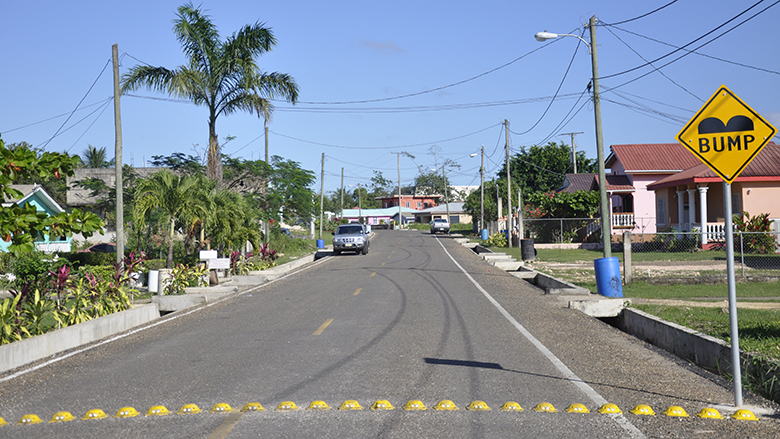Results
Bank financing for lending and analytical and advisory services supported the following results from 2010 to 2017:
- Enhanced climate resilience of key infrastructure: Given Belize’s vulnerability to climate shocks, an important objective of the Bank’s program was to strengthen public infrastructure, improve climate resilience and improve traffic signage. Significant progress was made in this regard under the MDP, which rehabilitated approximately 11 km of roads (versus a target of 4 km), built more than 19 km of drainage (more than 6 times the target), improved some 103 intersections, and posted 172 new traffic signs. The road rehabilitation and drainage works were designed with parameters on climate variability. Additional results under the MDP included the rehabilitation of the bus terminal in Belmopan, the extension of the municipal market in Dangriga, the rehabilitation of the administrative building in Punta Gorda, upgrading of the municipal market in Corozal, construction of a sporting facility in Corozal, upgrading of the central park in Orange Walk, and the construction of sidewalks in Benque Viejo. Finally, there was an overall institutional strengthening in the eight Town Councils and Cities (TCC) covered under this project: the TCCs designed economic development and growth plans through a participatory process, improved financial management and revenue collection, better traffic management, and asset maintenance plans.
- Enhanced human resilience and capital for a natural resource-based economy: More than 220 staff from TCCs were trained in municipal development, governance, revenue enhancement, municipal finance, and/or project management. These capacity-building activities have led TCCs to (a) increase tax collection;
(b) better manage and plan public finance expenditures; (c) coordinate and define investment priorities with local communities; and (d) increase stewardship of civil works delivered by the MDP. - Principles of environmental sustainability/climate resilience incorporated in development planning: The Bank-supported Non-Lending Technical Assistance for Natural Resources for Climate Resilient Growth (NRCRG) assisted the government to develop a 10-year National Climate Change Policy Strategy and Action Plan for 2015-2025, which was adopted by the Cabinet of Ministers in March 2015.
- Improved coordination on climate change across sectors: The Bank collaborated with the United Nations Development Programme, under the European Union-funded Global Climate Change Alliance grant (€2.9 million), to enhance adaptive capacity and resilience to climate change in national and sectoral policies, and to identify specific areas of engagement. The Bank financed analytical and advisory services focused on filling analytical gaps and undertaking consensus-building efforts to support the mainstreaming of a climate change adaptation agenda. Largely as a result of these coordinated efforts, the Belize National Climate Change Committee was established and is now fully operational.
- Enhanced effectiveness of the Environmental Impact Assessment System: With support from the NRCRG non-lending technical assistance and a US$6 million Global Environment Facility (GEF) grant for the Management and Protection of Key Biodiversity Areas Project, the Department of the Environment, Forest Department, and the National Environmental Assessment Committee have significantly improved their capacity to (a) conduct monitoring and compliance activities, (b) carry out consultations with local communities in remote forested areas, and (c) appraise environmental impact assessments necessary for obtaining licenses and permits.
Bank Group Contribution
From fiscal year 2011 to 2017, the Bank’s portfolio in Belize (consisting of operations financed by the Bank, through the International Bank for Reconstruction and Development (IBRD), and grants from Bank-administered trust funds) more than tripled, with the approval of the Climate Resilient Infrastructure Project (IBRD, US$30 million), the Marine Conservation and Climate Adaptation Project (Adaptation Fund, US$5.53 million), the Management of Key Biodiversity Areas (KBA) Project (GEF, US$6.09 million) and the Energy Resilience and Climate Adaptation Project (GEF, US$8 million). As of April 30, 2018, the Bank’s lending and trust fund portfolio in Belize consists of these four active projects, totaling US$49.62 million in lending commitments, and reflecting investments in various sectors including roads, energy, natural resources and environment.
Partners
The Ministry of Economic Development is the Bank’s main counterpart and serves as the coordinator for Bank engagement in the country. Under the overall support from the Ministry of Economic Development, the World Bank will continue to coordinate with and engage other partners in government for the implementation of the portfolio. Also, the Bank has coordinated with the Inter-American Development Bank in the area of road infrastructure given the complementarity of support being provided by the two institutions in Belize. In 2016, the World Bank and the Inter-American Development Bank jointly supported capacity building and training for the Ministry of Works in Road Asset Management.
Moving Forward
The Country Partnership Framework (CPF) for Belize covers the period from July 1, 2017 to June 30, 2022 (FY18-22). The Framework builds on the results and lessons of Belize’s first Country Partnership Strategy that covered the period FY12-15. The CPF is well aligned with the Government’s long-term development vision, Horizon 2030: National Development Framework 2010-2030, and the thematic priorities emerging from the 2016 Belize Systematic Country Diagnostic. The overarching goal of the proposed CPF is to support Belize in strengthening its economic resilience with particular focus on: (a) Fostering Climate Resilience and Environmental Sustainability; and (b) Promoting Financial Inclusion and Social Resilience.
Beneficiaries
In August 2017, Hurricane Matthew hit Belize. Anecdotal information indicated that little or no flooding resulted from the heavy rains in areas where road infrastructure works and rehabilitation had been implemented under the MDP. This showcased the increased resilience to adverse climatic events.
Additional benefits of the improved infrastructure include:
- Better access to critical infrastructure, such as schools, and to commercial areas in some municipalities;
- Improved aesthetics of some downtown areas;
- Improved physical and sanitary environment of some municipal markets; and
- Provision of additional and improved recreational facilities for all ages, thereby contributing towards the strengthening of family and community bonds.

